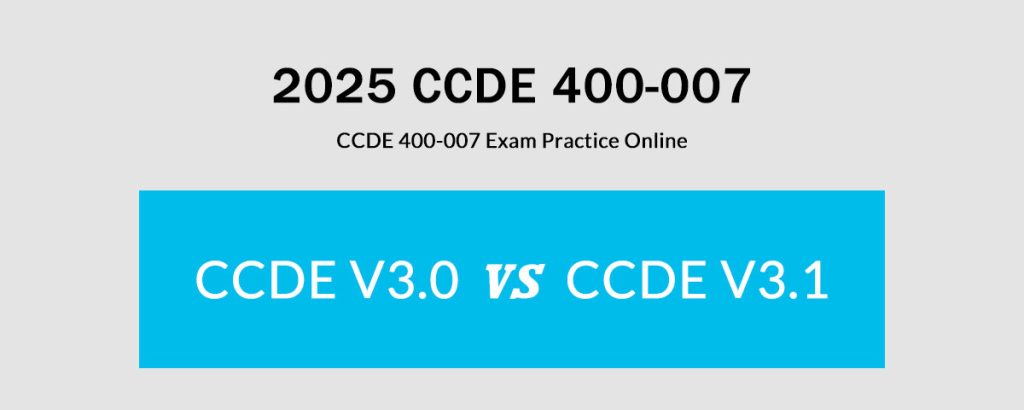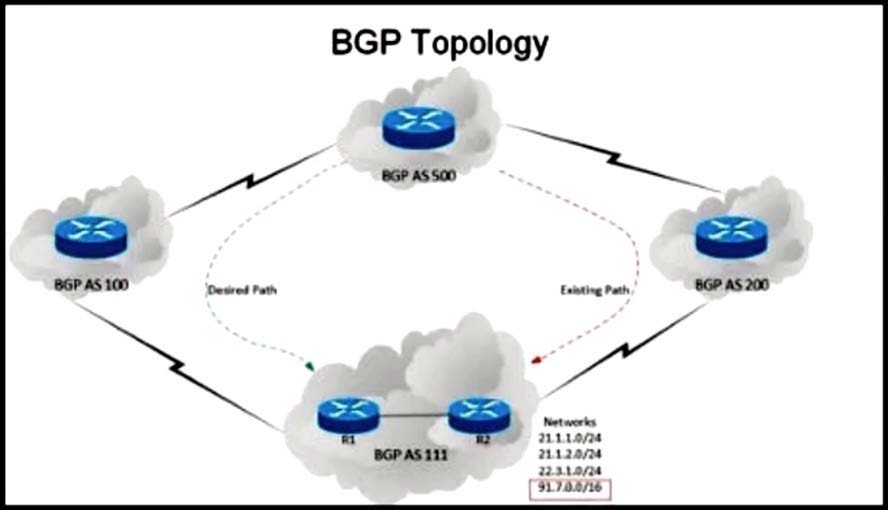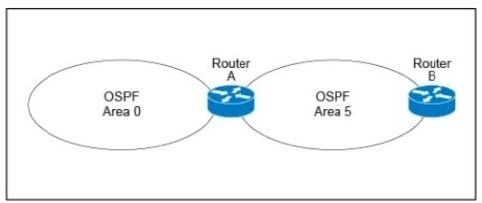
Starting February 7, 2025, the CCDE 400-007 (Cisco Certified Design Expert) will be updated to version 3.1.
Today, I will share the most effective 400-007 exam questions based on the latest version.
First, you need to understand the differences between CCDE 3.0 and CCDE 3.1, as this is crucial for aligning your study focus with the latest requirements.
The primary difference between CCDE v3.0 and CCDE v3.1 (400-007 exam) is the introduction of artificial intelligence (AI) and machine learning (ML) related topics in v3.1 to address modern network design requirements. Below are the specific differences based on the latest information:
Introduction of AI/ML-Related Content
| Aspect | CCDE v3.0 | CCDE v3.1 |
|---|---|---|
| AI/ML-Related Content | Not explicitly included. | Explicitly includes AI/ML-related topics. |
| Focus Areas | Emphasis on traditional networking technologies, such as routing protocols, SD-WAN, virtualization, and data center design. | Includes traditional networking technologies plus new AI/ML-related topics: |
| AI Infrastructure Design | Not covered. | Designing networks to support generative AI, large language models (LLMs), and small language models (SLMs). |
| AI Hardware and Acceleration | Not covered. | Tests understanding of GPU, SmartNICs, and DPU (Data Processing Unit). |
| Lossless Networks | Not covered. | Includes RDMA, RoCE/RoCEv2 for low-latency, high-throughput data transfer to support AI workloads. |
| Data Management | Not covered. | Includes storage protocols (e.g., NVMe, NVMe-oF) and efficient management of large datasets. |
| AI Security and Compliance | Not covered. | Covers data sovereignty, privacy protection, legal compliance, and ethical boundaries. |
| Sustainability and Optimization | Not covered. | Focuses on green AI, cost optimization, and power/cooling requirements. |
Changes in the Practical Exam
| Aspect | CCDE v3.0 | CCDE v3.1 |
|---|---|---|
| Exam Duration | 8-hour, scenario-based exam with four modules. | 8-hour, scenario-based exam with the same four-module structure. |
| Module Structure | Four modules, with the final module offering a choice of specialization: Large-Scale Networks, On-Prem/Cloud Services, or Workforce Mobility. | Retains four-module structure but adds AI Infrastructure as a specialization option. |
| AI Infrastructure | No AI Infrastructure specialization. | Introduces AI Infrastructure module, testing network design for AI/ML workloads, including hybrid solutions, data center connectivity, and business needs. |
Exam Difficulty and Preparation
CCDE v3.0:
Primarily focuses on traditional network design skills, such as CCNP/CCIE-level knowledge, architecture design, and business mapping.
Less emphasis on emerging technologies, primarily based on established network solutions.
CCDE v3.1:
Slightly increased due to the addition of AI/ML-related topics, requiring knowledge of AI infrastructure, hardware, and lossless networks.
Preparing for the CCDE 400-007 v3.1 exam is not overly difficult. In addition to understanding the latest topic changes and studying the newly introduced content mentioned above, using recommended third-party practice materials for practice tests can help you assess your learning progress in real time. Consider using CCDE 400-007 dumps ( https://www.leads4pass.com/400-007.html ), which include 397 up-to-date and valid exam questions and answers to assist you in effectively evaluating your preparation and ensuring successful passage of the exam.
At this point, you have understood the latest changes to the CCDE 400-007 exam and how to prepare to pass it.
Next, you can also participate in online practice tests.
2025 CCDE 400-007 Exam Practice Online
| Number of exam questions | Last updated | Related |
| 15 (Free) | 400-007 dumps | CCDE , CCNP , CCIE |
Question 1:
Refer to the table.

A customer investigates connectivity options for a DCI between two production data centers to aid a large-scale migration project. The migration is estimated to take 20 months to complete but might extend an additional 10 months if issues arise. All connectivity options meet the requirements to migrate workloads. Which transport technology provides the best ROI based on cost and flexibility?
A. CWDM over dark fiber
B. MPLS
C. DWDM over dark fiber
D. Metro Ethernet
Correct Answer: D
Question 2:
A business requirement is supplied to an architect from a car manufacturer stating their business model is changing to just-in-time manufacturing and a new network is required, the manufacturer does not produce all of the specific components m-house.
Which area should the architect focus on initially?
A. Automation
B. Zero Trust Networking
C. Low Latency Infrastructure
D. Modularity
Correct Answer: D
Question 3:
Company XYZ must design a strategy to protect their routers from DoS attacks, such as traffic destined to the router\’s own route processor, using separate control plane categories. Which two capabilities can be used to achieve this requirement? (Choose two.)
A. Control Plane Protection using queue thresholding on the transit subinterface
B. Control Plane Protection using port filtering on the transit subinterface
C. Control Plane Protection using port filtering on the main interface
D. Control Plane Protection using queue thresholding on the host subinterface
E. Control Plane Protection using port filtering on the host subinterface
Correct Answer: DE
Control-plane host subinterface. This interface receives all control-plane IP traffic that is directly destined for one of the router interfaces. https://www.cisco.com/en/US/docs/ios/qos/configuration/guide/ctrl_plane_prot_external_docbase_0900e4b1805eee4e_4container_external_docbase_0900e4b1814dc683.html#wp1124820
Question 4:
Agile and Waterfall are two popular methods for organizing projects. What describes any Agile network design development process?
A. working design over comprehensive documentation
B. contract negotiation over customer collaboration
C. following a plan over responding to change
D. processes and tools over individuals and interactions over time
Correct Answer: A
Question 5:
Refer to the exhibit.

An engineer has been asked to redesign the traffic flow toward AS 111 coming from AS 500.Traffic destined to AS 111 network 91 7 0.0/16 should come in via AS 100. while traffic destined to all other networks in AS 111 should continue to use the existing path.
Which BGP attributes are best suited to control this inbound traffic coming from BGP AS 500 Into the 91.7.0.0/16 network?
A. Prepend AS path for the 91.7.0.0/16 network and set it for neighbor in AS 200.
B. Use extended community for the 91.7.0.0/16 network, not advertising it to the bi-lateral peer.
C. Use local preference on R1 for the networks that AS 500 advertises to AS 111.
D. Set higher MED for neighbor in AS 100 to influence incoming traffic for the 91. 7.0.0/16 network.
Correct Answer: A
Question 6:
You are tasked to design a QoS policy for a service provider so they can include it in the design of their MPLS core network If the design must support an MPLS network with six classes, and CEs will be managed by the service provider, which QoS policy should be recommended?
A. map IP CoS bits into the IP Precedence field
B. map flow-label bits into the Exp field
C. map IP precedence bits into the DSCP field
D. map DSCP bits into the Exp field
Correct Answer: D
Question 7:
Company XYZ wants to redesign the Layer 2 part of their network and wants to use all available uplinks for increased performance. They also want to have end host reachability supporting conversational learning. However, due to design constraints, they cannot implement port-channel on the uplinks. Which other technique can be used to make sure the uplinks are in active/active state?
A. TRILL
B. LISP
C. MSTP
D. switch stack
Correct Answer: A
TRILL is a layer 2 protocol that enables multipathing and load balancing in the network by allowing multiple parallel paths between switches. This means that traffic can be distributed across all available uplinks, which would increase performance and availability.
Question 8:
Refer to the exhibit.

A customer runs OSPF with Area 5 between its aggregation router and an internal router When a network change occurs in the backbone. Area 5 starts having connectivity issues due to the SPF algorithm recalculating an abnormal number of times in Area 5 You are tasked to redesign this network to increase resiliency on the customer network with the caveat that Router B does not support the stub area.
How can you accomplish this task?
A. Increase the bandwidth on the connection between Router A and Router B
B. Implement LSA filtering ontheAB, allowing summary routes and preventing more specific routes into Area 5
C. Create a virtual link to Area 0 from Router B to the ABR
D. Turn on LSA throttling on all devices in Area 5
E. Set Area 5 to stubby at the ABR anyway
Correct Answer: B
Question 9:
Your company wants to deploy a new data center infrastructure Based on the requirements you have chosen VXLAN as encapsulation technology The customer is concerned about miss-configuration of Layer 2 devices and DC wide outages caused by Layer 2 loops.
What do you answer?
A. VXLAN offers native loop avoidance mechanism
B. Storm Control should be enabled on all ports
C. VPC+ could prevent L2 loop on access ports
D. BPDU Guard should be enabled on all VTEP access ports
Correct Answer: D
Question 10:
You are designing a network for a branch office. In order to improve convergence time, you are required to use the BFD feature Which four routing protocols can you use to facilitate this? (Choose four.)
A. IS-IS
B. static
C. RIP
D. EIGRP
E. BGP
Correct Answer: ABDE
Question 11:
A company requires an RPO of less than 10 seconds to ensure business continuity. Which technology should be deployed?
A. geographically dispersed data centers with asynchronous replication
B. a single data center with duplicated infrastructure, dual PSUs, and a UPS
C. geographically dispersed data centers with synchronous replication
D. a single data center with duplicated infrastructure and dual PSUs
Correct Answer: C
Question 12:
Which Interconnectivity method offers the fastest convergence in the event of a unidirectional issue between three Layer 3 switches connected together with routed links in the same rack in a data center?
A. Copper Ethernet connectivity with BFD enabled
B. Copper Ethernet connectivity with UDLD enabled
C. Fiber Ethernet connectivity with BFD enabled
D. Fiber Ethernet connectivity with UDLD enabled
Correct Answer: C
Question 13:
A banking customer determines that it is operating POS and POI terminals that are noncompliant with PCI DSS requirements, as it is running TLSv1.0. The customer plans to migrate the terminals to TLSv1.2. What are two requirements to complete the migration? (Choose two.)
A. Ensure that strong cryptography is applied for users who have administrative access through networks
B. Apply strong cryptography and security protocols to safeguard sensitive cardholder data.
C. Apply strong encryption for transmission of cardholder data across public networks.
D. Protect all user systems against malware and frequently update antivirus software
E. Maintain a policy that addresses information security for employees and third parties.
Correct Answer: BC
Question 14:
Various teams in different organizations within an enterprise are preparing low-level design documents to capture network parameters using a Waterfall project model:
hardware sizing and power consumption
Layer 2 and layer 3 services parameters
configuration of all control plane protocols
Input from relevant stakeholders was captured at the start of the project, and the project scope has been defined based on the parameters above.
What impact will it have on documentation and project deliverables if the stakeholders ask to have changes carried out in the network before the information has been captured?
A. This provides more opportunity to think outside the box.
B. Rework is expected before the delivery.
C. Significant effort and time are required.
D. This provides a flexible approach to incorporate changes.
Correct Answer: B
Redo work is expected for whole project, but the situation of the question is more focus on very early stage.
Waterfall can require that a phase be fully completed before proceeding to the next one, and it\’s extremely difficult to go back if you miss anything. That means you and your team must check every box before moving on, or there could be a lot of rework needed. This could easily derail your schedule since there are many dependent relationships between tasks—every day of delay is another day added to your overall schedule. https://www.clearpointstrategy.com/blog/waterfall-project-management
Question 15:
Company XYZ is running SNMPv1 in their network and understands that it has some flaws. They want to change the security design to implement SNMPv3 in the network.
Which network threat is SNMPv3 effective against?
A. man-in-the-middle attack
B. masquerade threats
C. DDoS attack
D. brute force dictionary attack
Correct Answer: D
…
Conclusion
400-007 CCDE certification is a long-term investment! V3.0 now to V3.1 in 2025 is very useful and will be of great help to your future career development.
However, you should start creating a study plan for the 400-007 CCDE certification exam today to help you enter the field of network design engineers as early as possible to meet the demanding demands of future artificial intelligence jobs.
Whether you are a newbie or an experienced candidate, good certification exam practices can help you achieve your goals. The new 400-007 CCDE certification exam questions: https://www.leads4pass.com/400-007.html, can really help you achieve success easily.